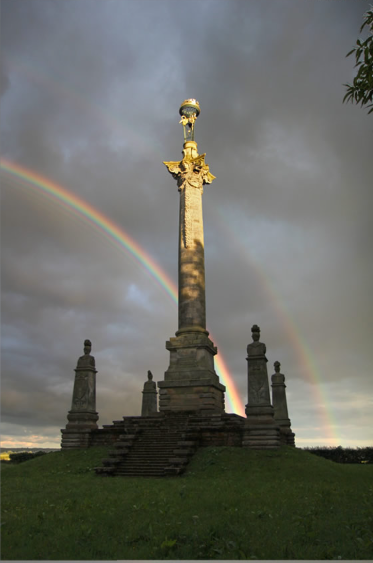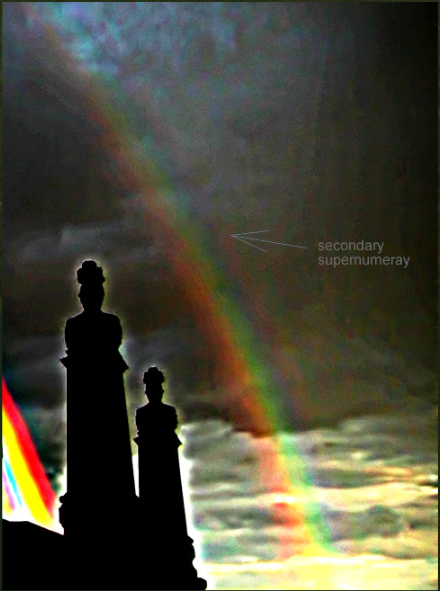OPOD - Rare Secondary Supernuimerary
OPOD - Rare Secondary Supernumerary
Atmospheric optics never fails to surprise us with its captivating displays of light and color. One such extraordinary phenomenon is the rare secondary supernumerary, which adds a touch of magic to the already enchanting rainbow. While primary and secondary supernumeraries are relatively common, the appearance of a secondary supernumerary outside the secondary bow is a true rarity.
When photographer Matt Howker set out on his sunset shoot near Castle Howard, Yorkshire, England, he was greeted by an astonishing sight. A brilliant rainbow adorned the sky, with the main bow shining brighter than any he had ever seen before. The timing was perfect, as a rain shower had just passed over, leaving behind a cloud shade that enhanced the visibility of the rainbow. Despite the changing intensities of the supernumeraries and the secondary bow over the 7 minutes Howker captured the scene, the main bow remained consistently full and radiant. Such a spectacle deserved to be preserved, and Howker's decision to stick with his lens choice proved to be a wise one.
The primary charm of this optical display lies in the presence of supernumerary bows. These additional bands of colors are stacked within the inner primary bow, indicating that the rainbow originated from small and uniform-sized raindrops. However, what truly sets this phenomenon apart is the appearance of a supernumerary outside the secondary bow. Although faintly visible to the right of the secondary bow where it crosses a dark cloud, this rare secondary supernumerary becomes more prominent when the image is enhanced using techniques like levels adjustment and deep unsharp masking.
Spotting a secondary supernumerary is an uncommon occurrence. To increase your chances of witnessing this elusive phenomenon, keep an eye out for bright primary supernumeraries and a dark cloud background. The contrast provided by the dark cloud helps bring out the faint secondary supernumerary.
Understanding the science behind rainbows allows us to appreciate the beauty and complexity of these atmospheric wonders. René Descartes, in his groundbreaking 1637 theory of the rainbow, proposed that light travels in straight lines unless refracted or reflected. This theory elegantly explains and predicts the formation of the primary and secondary bows. However, supernumerary bows pose a challenge to Descartes' theory. These bows arise from the overlapping and interfering waves of light. Each angular direction of a rainbow is produced by waves that take two different paths through raindrops. Since these paths are not of the same length, the wave crests can either align perfectly, be partially out of sync, or completely out of sync, depending on the position within the rainbow and the size of the raindrops. In-step waves create bright fringes, while out-of-step waves result in darkness.
The monument on Bulmer Hill, part of the Castle Howard estate, adds historical significance to the picturesque scene captured by Matt Howker. Erected in 1869/70 to honor George William Frederick Howard, the 7th Earl of Carlisle, the 120 ft high monument stands as a testament to the Howard family's legacy and their connection to this magnificent landscape.
Witnessing a rare secondary supernumerary is truly a once-in-a-lifetime experience. It serves as a reminder of the intricate nature of atmospheric optics and the boundless beauty that surrounds us. The next time you find yourself gazing at a rainbow, take a moment to appreciate its awe-inspiring details, for you never know what optical treasures might be hiding within its colorful arcs.

Primary, Secondary & Rare Secondary Supernumerary
By Matt Howker near Castle Howard, Yorkshire, England with the June evening sun 6° high. ©Matt Howker, shown with permission

"Having gone out for another sunset shoot, I noticed this very bright rainbow. What caught my eye, to start with, was the brilliance of the main bow. It was the 'golden hour' before sunset and a rain storm/shower had just passed over. I was in cloud shade which helped, I think, but this was still the brightest bow I've ever seen. The supernumeraries and secondary bow intensities changed over the 7 minutes these pictures were taken, however the main bow remained full and bright throughout and for some time after. There were a few spots of rain about so I didn't want to change to a wider lens."
A glorious optical display with supernumerary bows as the gems. Multiple supernumeraries are stacked inside the inner primary bow indicating a rainbow origin from small and uniform sized raindrops. But the rarity is the supernumerary outside the secondary bow. It is already faintly visible to the right of the secondary bow where it crosses the dark cloud. The larger of the unprocessed images shows it best. At lower right it is made more obvious by severe enhancement (levels and deep unsharp masking).
A secondary supernumerary is a very uncommon sight, look for one whenever there are bright primary supernumeraries and there is a dark cloud background to enhance contrast.
Descartes� 1637 first scientific theory of the rainbow involved light travelling in straight lines except where refracted or reflected. It neatly explains and predicts the inner primary and outer secondary. It cannot explain supernumerary bows because they arise from waves overlapping and interfering with one another. Each angular direction of a rainbow is supplied by waves that travel via two routes through raindrops. Their paths are not of the same length and so their wave crests can be in step, partially out of step or completely out of step depending on the position in the rainbow and the raindrop sizes. In-step waves give a bright fringe, out of step waves darkness.
The monument on Bulmer Hill is part of the Castle Howard estate, the private residence for some 300 years of the Howard family. The 120 ft high monument, erected in 1869/70 by public subscription, celebrates George William Frederick Howard the 7th Earl of Carlisle.
Note: this article has been automatically converted from the old site and may not appear as intended. You can find the original article here.
Reference Atmospheric Optics
If you use any of the definitions, information, or data presented on Atmospheric Optics, please copy the link or reference below to properly credit us as the reference source. Thank you!
-
<a href="https://atoptics.co.uk/blog/opod-rare-secondary-supernuimerary/">OPOD - Rare Secondary Supernuimerary</a>
-
"OPOD - Rare Secondary Supernuimerary". Atmospheric Optics. Accessed on April 23, 2024. https://atoptics.co.uk/blog/opod-rare-secondary-supernuimerary/.
-
"OPOD - Rare Secondary Supernuimerary". Atmospheric Optics, https://atoptics.co.uk/blog/opod-rare-secondary-supernuimerary/. Accessed 23 April, 2024
-
OPOD - Rare Secondary Supernuimerary. Atmospheric Optics. Retrieved from https://atoptics.co.uk/blog/opod-rare-secondary-supernuimerary/.